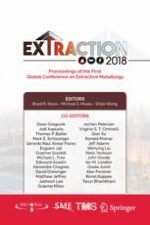2018 | Buch
Extraction 2018
Proceedings of the First Global Conference on Extractive Metallurgy
herausgegeben von: Boyd R. Davis, Prof. Michael S. Moats, Dr. Shijie Wang, Dr. Dean Gregurek, Ph.D. Joël Kapusta, Thomas P. Battle, Prof. Mark E. Schlesinger, Gerardo Raul Alvear Flores, Dr. Evgueni Jak, Graeme Goodall, Prof. Michael L. Free, Edouard Asselin, Alexandre Chagnes, Prof. David Dreisinger, Matthew Jeffrey, Dr. Jaeheon Lee, Graeme Miller, Jochen Petersen, Virginia S. T. Ciminelli, Qian Xu, Ronald Molnar, Jeff Adams, Wenying Liu, Niels Verbaan, John Goode, Ian M. London, Gisele Azimi, Alex Forstner, Ronel Kappes, Tarun Bhambhani
Verlag: Springer International Publishing
Buchreihe : The Minerals, Metals & Materials Series
